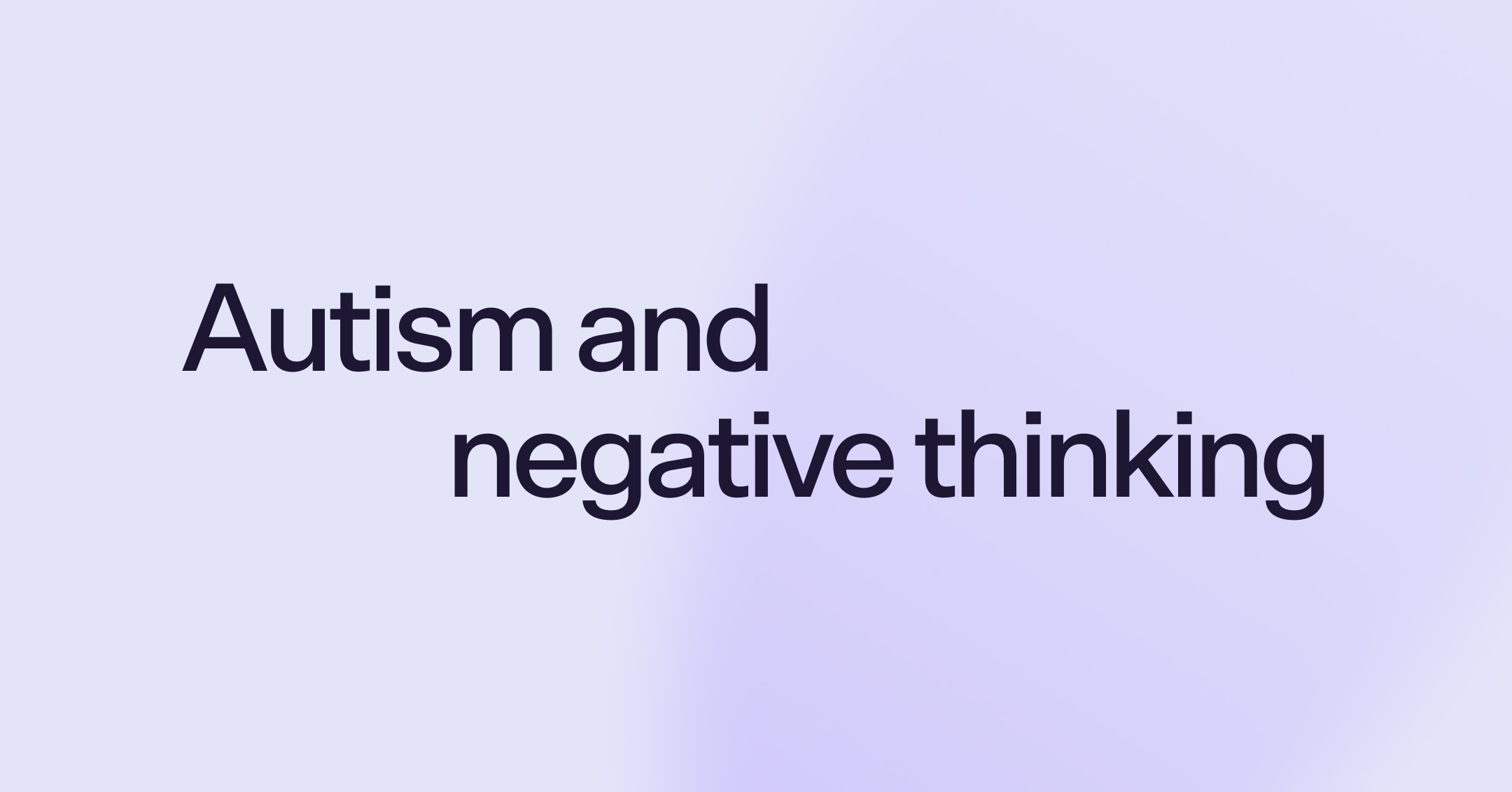Negative thoughts are unhelpful perceptions that can lead to frustration and self-doubt. For people with autism, characteristics like rigidity and communication challenges may contribute to negative thinking.
Types of negative thinking can include catastrophizing, overgeneralizations, and black-and-white thinking.
Cognitive reframing is a tool that can help people identify unhelpful thought patterns and beliefs and replace them with more empowering alternatives.
People with autism spectrum disorder (ASD) process and communicate information differently than neurotypical people. This can lead to a unique combination of strengths and challenges that shape how they view the world.
For example, many autistic people have a remarkable eye for detail and a knack for critical thinking. On the flip side, they may also be more likely to misunderstand social cues or struggle to convey their own thoughts and emotions. For some people with autism, this can contribute to negative thought patterns or cognitive distortions.
Where does negative thinking come from?
Negative thoughts are unhelpful or pessimistic perceptions about yourself, other people, or life events. Certain autism characteristics may increase people’s chances of experiencing negative thinking. For example, rigid thought and behavior patterns can make it difficult to accept change or see the positive when things don’t go as planned.
It’s also common for autistic people to struggle with social interactions, which can contribute to negative thoughts involving fear, insecurity, and self-doubt. People with autism may also be more likely than neurotypical people to fixate on negative or distressing thoughts.
Negative thinking is associated with cognitive distortions, which are inaccurate or irrational ways of thinking. There are several types of cognitive distortions that can influence how people view and interpret the word.
Cognitive distortions include:
Catastrophizing: Catastrophizing is when you consistently expect the worst outcome. For example: “If I mess up this project, my career will be over.”
Overgeneralization: This is when you assume that one experience — especially a negative one — will apply to all future events. For example: “No one asked me to sit with them at lunch today, so I’ll have to eat alone forever.”
Black-and-white thinking: Black-and-white thinking — also known as dichotomous thinking — is when you think in absolutes or extremes. For example: “My idea to get better sleep will never work.”
Labeling: This is when you attribute your identity or self-worth to a single event. For example: “I made a mistake on my math test, so I must be a failure at school.”
The care you need, when you need it
Learn how Rula can support your mental health journey
How can negative thoughts affect people with autism?
Frequent and repetitive negative thinking often contributes to mental health problems like stress, anxiety, and depression in people with autism. Over time, negative thoughts can lead to feelings of shame and low self-esteem, as well as interpersonal problems and poor decision-making skills.
But while autistic people may have increased levels of uncomfortable emotions, negative thinking doesn’t have to be part of life with autism. By working with a therapist, autistic people can learn to reframe negative thoughts and navigate life with a more optimistic outlook.
Five tips to stop negative self-talk
Talk therapy — such as cognitive behavioral therapy (CBT) — is an effective tool for addressing negative thinking in people with autism. With CBT, people can learn how unhealthy thoughts impact their moods, behaviors, and overall outlook on life. Working with a therapist can provide you with the skills to navigate challenging situations, reframe negative thoughts, and feel more confident in your coping mechanisms.
In addition to getting help from a mental health professional, there are some strategies you can try on your own to help you combat negative thinking.
Try cognitive restructuring. Start by identifying the negative or unhelpful thoughts that you notice throughout your day. From there, use cognitive reframing to replace or respond to these thoughts with more helpful thoughts and beliefs. By addressing negative thought patterns, you can learn to explore more empowering perspectives.
Do mindfulness exercises. Mindfulness can help you calm your mind and center yourself in the present. Through exercises like deep breathing, guided imagery, and meditation, you can learn how to focus on the current moment so you’re not distracted or overwhelmed by your thoughts and feelings.
Use positive affirmations. Positive affirmations are designed to help people challenge unhelpful or irrational thoughts and cultivate greater self-compassion. For example: “I love myself just the way I am.”
Lean on your support system. The next time you find yourself falling into a negative thought cycle, connect with a friend, and let someone in on what you’re going through. You may even benefit from joining a support group with other autistic or neurodivergent people.
Build new skills. Once you identify negative thought patterns, you can focus on developing the skills to build confidence despite those concerns. For example, if social situations are triggering your negative thoughts, social skills training can help you build the tools to feel more confident around others.
Focusing on autistic people’s strengths allows me to adapt cognitive behavioral therapy and other interventions. This could look like asking them to use their increased memory capacity to remember and identify negative thoughts.

Elise Miller, MA, LPC
Clinical reviewer
Find care with Rula
Living with autism and negative thoughts can affect your relationships, sense of self, and worldview. The good news is that it’s possible to change your perspective with the right strategies and support.
At Rula, we’re committed to delivering a comprehensive behavioral health experience that helps people feel seen and understood so they can get back to feeling their best.
Rula makes it easier to find a licensed therapist or psychiatric provider who accepts your insurance so you don’t have to choose between affordable care and excellent care. With a diverse network of more than 15,000 providers, 24/7 crisis support, and appointments available as soon as tomorrow, we’re here to help you make progress — wherever you are on your mental health journey.
Rula's editorial process
Rula's editorial team is on a mission to make science-backed mental health insights accessible and practical for every person seeking to better understand or improve mental wellness.
Members of Rula’s clinical leadership team and other expert providers contribute to all published content, offering guidance on themes and insights based on their firsthand experience in the field. Every piece of content is thoroughly reviewed by a clinician before publishing.




